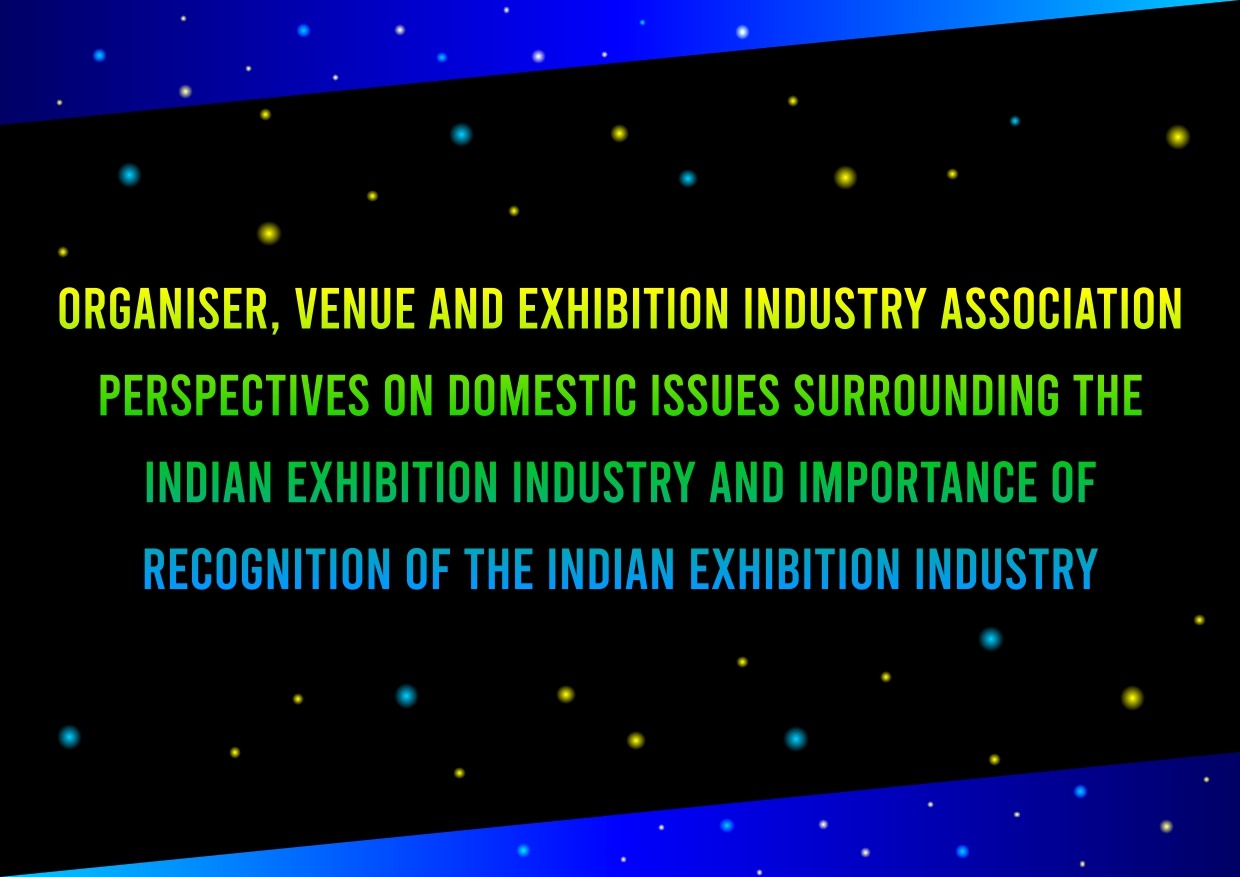Organiser, Venue and Exhibition Industry Association Perspectives on Domestic Issues Surrounding the Indian Exhibition Industry and Importance of Recognition of the Indian Exhibition Industry
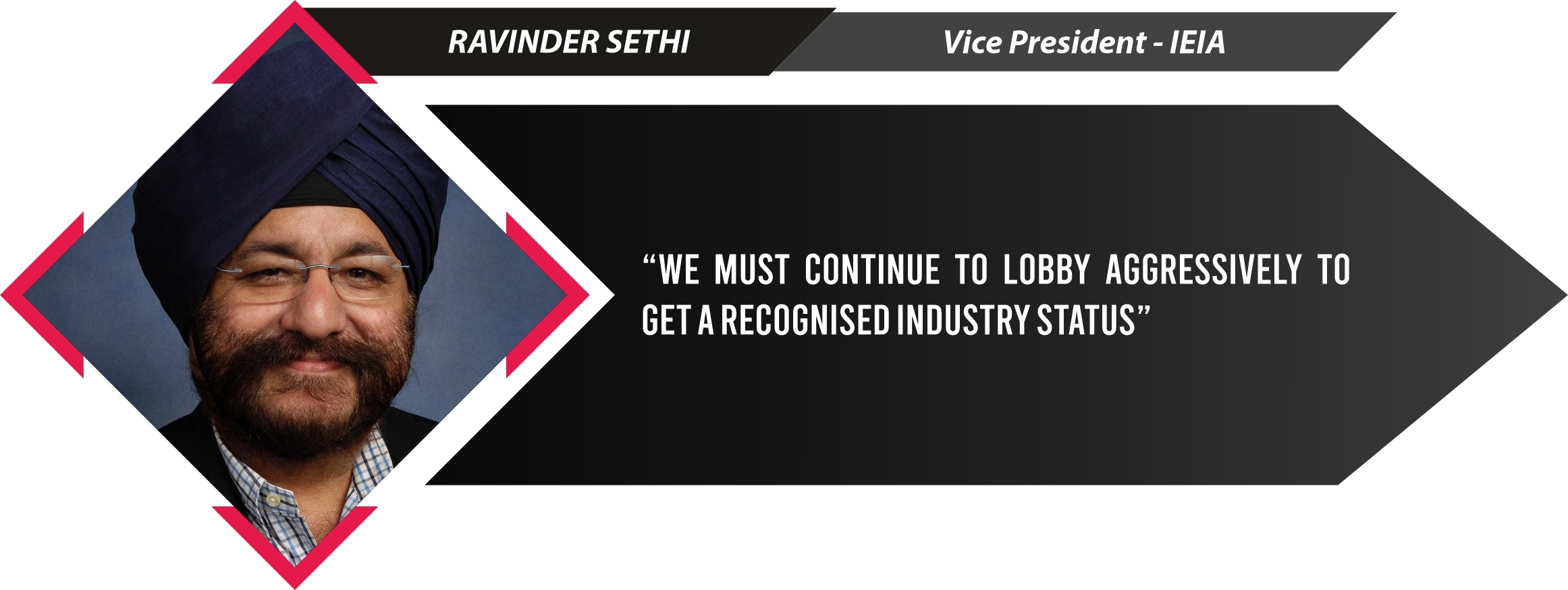
1. What’s your perspective on the Domestic Exhibition Sector getting an Industry Status (Recognised Industry)?
RS: We’ve been talking on this for years now but we’re now getting somewhere . I’d say an indirect recognition has come with Government’s direct involvement on two mega venue projects – the upcoming IICC in Dwarka and the reconstruction of Pragati Maidan.
Why I say ‘indirect’ is that Government at least recognizes the dire infrastructure needs of our industry – the next logical step should be giving us Industry Status.
2. According to you, how can our Exhibition Industry get a recognised industry status?
RS: We must continue to lobby aggressively for this and this to be done in two ways.
The first is via our Association. The IEIA is already playing a very constructive role. The recently concluded Open Seminar had two powerful bureaucrats – Commerce Secretary and ITPO CMD – in our midst as supporters and friends . The IEIA is taking it forward with them for getting us Industry Status .
The second is via our media . This is where esteemed publications , like your good selves , must play a constructive and mature role in projecting our concerns . Criticism is definitely healthy as long as it is constructive . Sometimes I feel media only wish to be critical and this is not good for our industry.
3. From your perspective, what are the domestic issues surrounding our Industry?
RS: I’d mentioned in my Open Seminar address . ‘Ease to do business’ needs a lot more doing . A lot has been done but it needs to become ‘easier to do business’ .
The other major issue is taxation and financial related. Unlike the tourism sector , we still don’t get the adequate attention we’re rightfully deserve for.
4. Why do you think the Indian Trade Fair Industry is still unrecognised?
RS: It’s easy to straightaway put blame on government for this , but that wouldn’t be correct . We’re a developing economy with millions of priorities in the last many decades – many which were probably much more important than ours . So , maybe , our time has come now.
However , having said the above , I think our time could have come earlier if our lobbying mechanism was more powerful and had been in place earlier.
5. What would you suggest to the apex bodies of our Industry to undertake this initiative?
RS: Put your heart and soul in it and we’ll get our results!
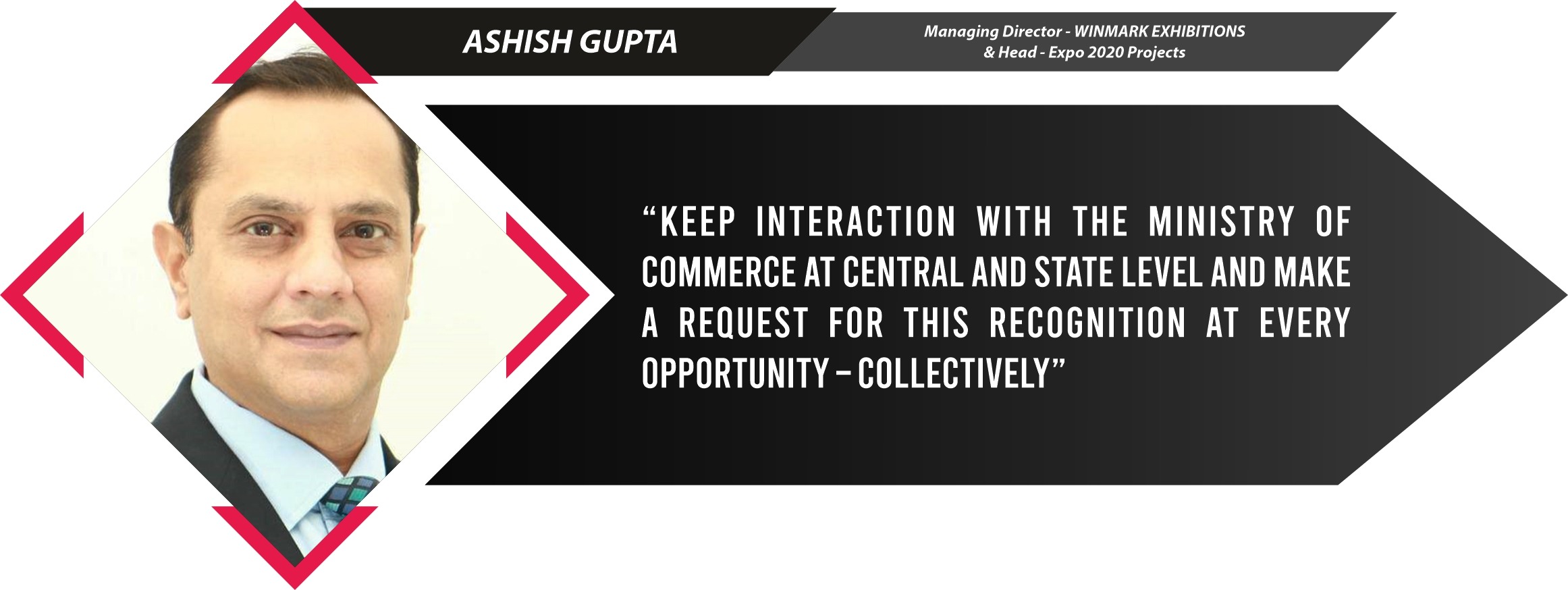
- What’s your perspective on the Domestic Exhibition Sector getting an Industry Status (Recognised Industry)?
AG: The Indian exhibition industry has been thriving and been an integral part of the Indian economy. I think it would be great for the Domestic Exhibition Sector to get an Industry Status.
- According to you, how can our Exhibition Industry get a recognised industry status?
AG: Our exhibition industry can get a recognized industry status by organizing more events catering to international audiences. If marketed well, we are on the roadmap to getting a recognized industry status. Alongside that, we should even be able to take the exhibition and make it global.
- From your perspective, what are the domestic issues surrounding our Industry?
AG: The domestic issues surrounding the industry can be lack of resources, lack of advanced technologies and lack of using data resourcefully. Also, a lot of exhibitions old school concepts of organizing the event and marketing for the same. I think social media plays a major role in making an event global.
- Why do you think the Indian Trade Fair Industry is still unrecognised?
AG: I think the Indian Trade Fair industry is still unrecognized as it is underestimated. The Indian exhibition industry has had a growth rate of 8.8% annum and has been boosting the Indian economy. The Indian Trade Fair Industry has been a host to massive exhibitions, which have led to great amount of revenues for the exhibitors and visitors
- What would you suggest to the apex bodies of our Industry to undertake this initiative?
AG: Keep interaction with the Ministry of Commerce at Central and State level and make a request for this recognition at every opportunity – collectively. Associations that organise exhibitions are also regularly in touch with several ministries, they should also keep asking. Last – the day exhibitors start feeling the positive benefits and effect of trade fairs and the important impact that it creates for them. Exhibitors should also endorse this move. Collectively the market forces can create the required momentum to achieve this objective.

- What’s your perspective on the Domestic Exhibition Sector getting an Industry Status (Recognised Industry)?
OP: Indian exhibition industry has been growing gradually, with increase in the no. of trade exhibitions that are being held in major metro cities of India. As these exhibitions combine exhibitions of domestic nature as well as of international level, our Domestic Exhibition Sector is fully grown up to get Recognised Industry Status.
- According to you, how can our Exhibition Industry get a recognised industry status?
OP: There are norms decided by the Ministry of Industries, Govt. of India, which need to be fulfilled by the Industry applicants for being Recognised Industry Status. Nevertheless Govt. cannot ignore the vast impact of Indian Exhibition Industry in the development of Indian economy and the promotion of trade, thereby providing boost to Indian industry.
To recognise the Indian Exhibition Industry, the Govt. should see the multiple impacts on direct and indirect about its contribution. The Govt. should recognise the multiple effects of Exhibition industry on the development of various sectors. Short introduction is mentioned below:
As per the available facts, in India it is estimated at Rs.65000 crore with over 700 major Trade Shows taking place every year at a growth rate of 12% per annum. It provides immense opportunities for the development and growth in tourism, hotel reservations, government initiatives, pumps event companies and suppliers businesses and a host of ancillary businesses linked directly and indirectly to the exhibitions.
- From your perspective, what are the domestic issues surrounding our Industry?
OP: There are various issues surrounding our exhibition industry. Few are listed below:
- Exhibition venues are not at par with international standards.
- Lack of facilities to the domestic exhibitors and more so to the international exhibitors.
- International exhibitors should be attracted to exhibit in India by sops of facilities and incentives, rather than strict rules and regulations especially of the Indian Customs speedy clearance and supporting policy to encourage international exhibitors is very much lacking in comparison to the counterpart exhibitions abroad like Germany, USA etc.
Other issues surrounding our exhibition industry are transporting of goods and to relax interstate restrictions.
- Need to create a common platform which should include all the service providers who can help the exhibitors at one place.
- Need support of venue based one point facilities to exhibitors and visitors such as Hotel, Transportation, Restaurants, Banks, Communication Centres and Tourism Office. These facilities are provided by international Exhibition Organisors to Visitors and Exhibitors.
- Why do you think the Indian Trade Fair Industry is still unrecognised?
OP: As the Indian exhibition industry has not achieved various qualitative requirements to speedily help the exhibitors and visitors, it remains as an unrecognised industry.
- What would you suggest to the apex bodies of our Industry to undertake this initiative?
OP: The Apex bodies of our industry should get together and work on the following:
- Create a common platform which should include Govt. departments applicable to exhibitions. One window clearance representing all the required departmental issues.
- To seek subsidies from various departments and to encourage the exhibition entrepreneurs.
- To include media partners at one platform
- To provide speedy refunds of any deposits paid by exhibitors
- To promote Indian exhibitions at world platforms
- To create a common platform to include all service providers
Conclusion:
We should not forget that Trade Fairs are a key driver to national and international trade in goods and services. They are important marketing instruments in B2B communications and they intensify competition and trade in all economic regions of our country and abroad ensuring growth and jobs. Economic globalization and an increased orientation towards brand names are additional factors promoting the worldwide importance of these sectors – specific market places. In the process, trade fair Organisers are developing into marketing partners for businesses in ever more comprehensive ways. Hence I strongly feel that Exhibition Industry is a strong component of India’s economy and deserves all support and recognition as Recognised Industry Status for its future growth.
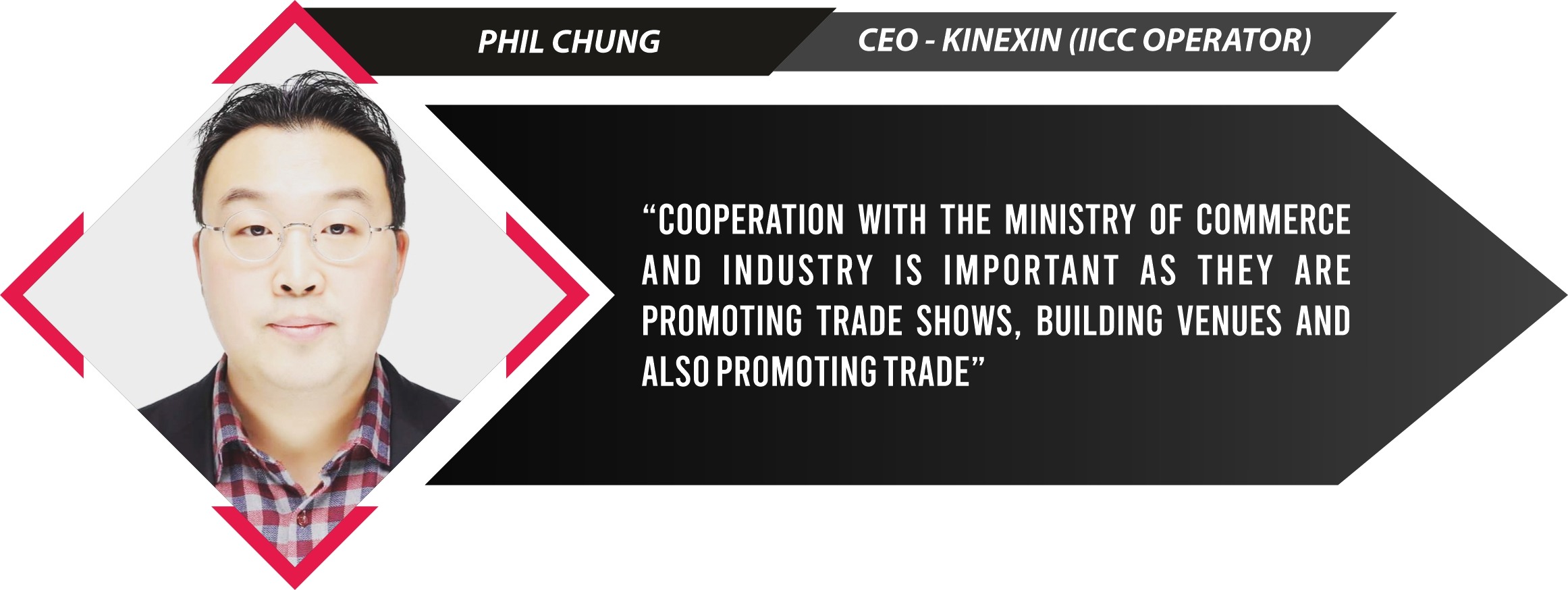
1. What’s your perspective on the Domestic Exhibition Sector getting an Industry Status (Recognised Industry)?
PC: Cooperation with Ministry of Commerce and Industry may be important as they are promoting tradeshows, building venues like IICC(www.iiccnewdelhi.com) and promoting trade. MICE experts and forums should include the ministry and make many meaningful policy. Important policy advisors like NITO Aayog will also help if we could invite them to our many MICE forums.
We have recently initiated New Delhi NCR MICE Forum, I believe it will be of help in that regard.
2. According to you, how can our Exhibition Industry get a recognised industry status?
PC: Now Indian MICE sector is doing good. It is already a robust industry. Many global organizers are controlling the market but making internal policies and issues better be done by Indian organizers with such policy makers. And boosting the level of public awareness will help a lot more. IICC will be a amazing platform to provide such abundant opportunities to all organizers to grow new consumer shows under our incubation policies.
3. From your perspective, what are the domestic issues surrounding our Industry?
PC: Viable venues. But once IICC gets completed next year, the industry demand is expected to surge, which will grow about 2 times over the next 7 years.
4. Why do you think the Indian Trade Fair Industry is still unrecognised?
PC: No. It is recognized. As a foreigner, I can see it.
5. What would you suggest to the apex bodies of our Industry to undertake this initiative?
PC: Work closely with government to help them promote many important government agenda, they should associate more often with important ministries and think tank to get their urgent agendas reflected and promoted in their trade shows and conventions.
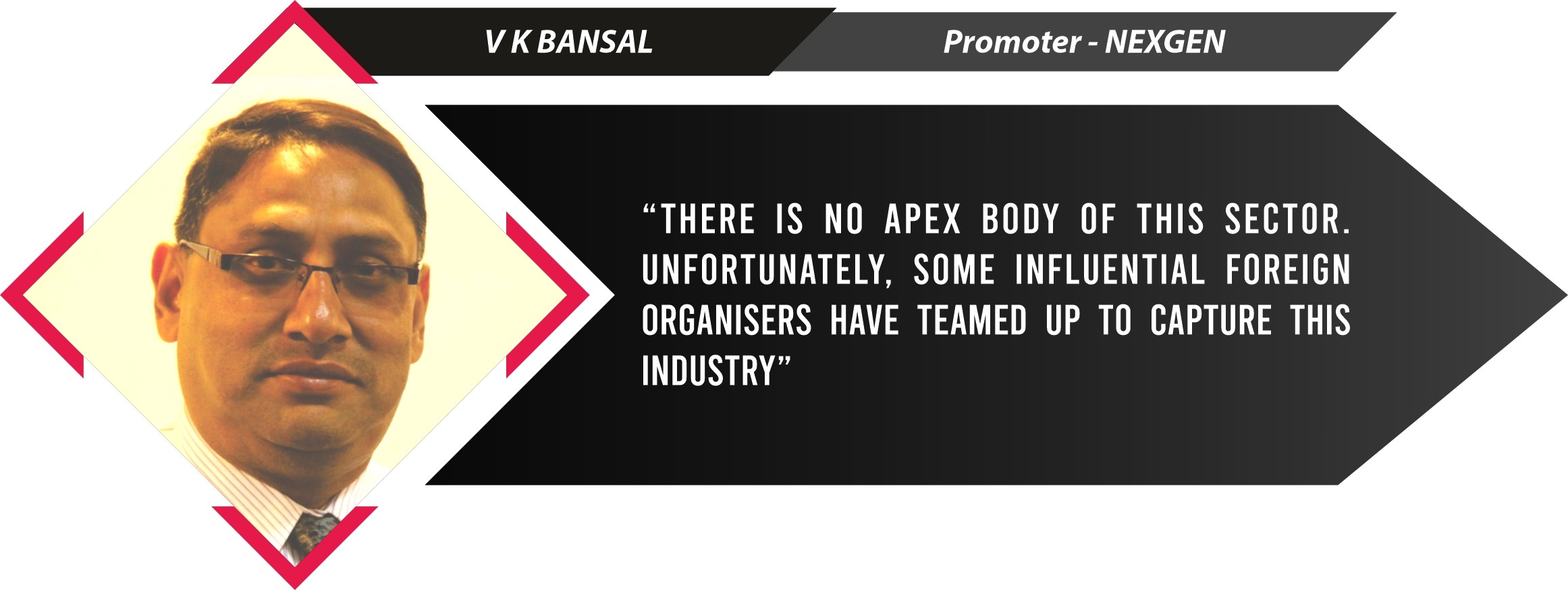
- What’s your perspective on the Domestic Exhibition Sector getting an Industry Status (Recognised Industry)?
VKB: After GST in place , all three segment of economy viz Industry,Services and Trading has become into one business. In India there are no separate policies for any segment rather there are several different polices like Manufacturing, Exports etc. There is no impact if Exhibitions remains a Service sector.
- According to you, how can our Exhibition Industry get a recognised industry status?
VKB: What we are doing we must know.We are providing and facilitating our exhibitors to showcase their product and technology . We are a very much Service Sector as we are enjoying a sort of sub lease rental. Second question why we need an Industry tag? what will we achieve if we are classified as Industry?
- From your perspective, what are the domestic issues surrounding our Industry?
VKB: A lot of issue are impacting growth of Indian Exhibition Industry. First of all we need an umbrella support from our respective ministry or ministry of Commerce. Until Government will not handhold organisers, we would not be able to reap real benefit from Exhibition Sector. ITPO should act as nodal agency for growth and development of Exhibition sector and small and medium sized organisers should be given certain exhibitions. Domestic exhibition industry should be protected from foreign organisers.
- Why do you think the Indian Trade Fair Industry is still unrecognised?
VKB: Yes to some extend. There is no umbrella / nodal organisation to make us organised.
- What would you suggest to the apex bodies of our Industry to undertake this initiative?
VKB: There is no apex body of this sector. Unfortunately some influential foreign organisers have team-up to capture this industry . As Indian Organisers, we should have certain benefits and privileges from Government. Unfortunately, Industry bodies and trade associations have entered into this segment which is killing small and medium organisers. We should have strong IP right protection mechanism. ITPO which is venue providers also organises its own exhibitions and create unhealthy competition as they sell much below of our rentals. This also needs to be looked into.

1. What’s your perspective on the Domestic Exhibition Sector getting an Industry
Status (Recognized Industry)? According to you, how can our Exhibition
Industry get a recognized industry status?
BIEC: Exhibitions are a significant contributor to the economy and together with MICE create a multiplier effect. They contribute around 8 – 10 times of their turnover (in direct and indirect spends) to the geographical area they serve. As per Indian Exhibition Industry Association (IEIA) over 700 trade fairs held in India directly contribute over Rs. 25,000 crores to the economy every year. India is a sought after destination by event organizers due to its industry-friendly policies and ease of doing business. With an annual growth rate of around 10% the exhibitions industry is growing at a rate faster than the country’s GDP.
Exhibition industry supports the growth of various other industries including many ancillary
industries and services in the value chain such as hotels, tourism, aviation, logistics, transportation, and many more. It is also a big employment generator. We need to make the government aware of the economic impact of the exhibition industry on these many sectors and advocate for getting an industry status.
2. From your perspective, what are the domestic issues surrounding our Industry? Why do you think the Indian Trade Fair Industry is still unrecognized? What would you suggest to the apex bodies of our Industry to undertake this initiative?
BIEC: Indian exhibition industry is gradually becoming organized and tapping the enormous potential provided by the country’s growing economy. Exhibition venue infrastructures are being upgraded for conducting large-scale exhibitions. It is very important to enhance the skill sets of exhibition industry professionals. Realizing its importance organizations such as UFI and IAEE (through IEIA in India) are conducting training programmes for imparting workers with requisite skills. The UFI Exhibition Management Degree (EMD) programme is valued across the globe as it helps professionals meet tomorrow’s event management demands. The IAEE “Certified in Exhibitions Management” is a globally renowned programme that has helped professionals and organizations in the country to gain knowledge, expertise and skills at par with the international standards contact. In India it is driven by IEIA. Exhibition venue owners are also constantly improving the quality of services so that new shows can find their way to India. Industry is also developing a common code which is standardizing the entire exhibition industry and its value chain. Many new venues are being upgraded / built in Tier 2 and Tier 3 cities in India.
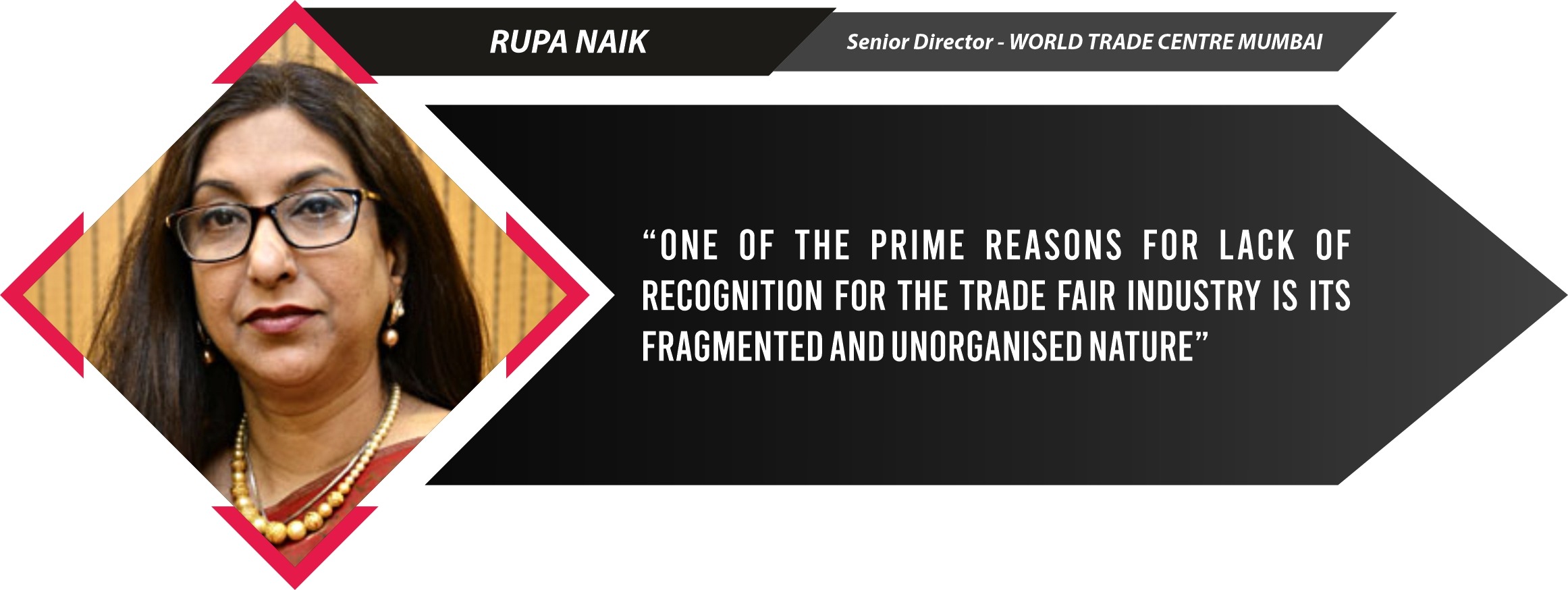
1. What is your perspective on the domestic exhibition sector getting an industry
status (recognized industry)?
RN: Exhibition sector plays an important role in promoting employment, international trade
and overall economic growth of a country. Domestic and global organizers have conducted around 615 trade events in India during 2018, thereby contributing approximately Rs. 27,500 crore to the nation’s GDP (according to industry body IEIA). This figure does not include the contribution of the unorganised players in the exhibition sector.
Exhibition sector contributes to the economy directly by creating employment opportunity for stall decorators, DTP designers, equipment suppliers, house keeping personnels, food caterers, among others. The sector also makes indirect contribution to the economy by enhancing the market reach of companies, facilitating B2B meetings and thereby improving the sales prospects of business organizations.
The sector also promotes tourism, hotel and food industries indirectly. Further, trade fairs help in developing cross-country collaboration and promoting foreign direct investment by bringing together the business community of various countries. More significantly, exhibition can support sustainable development goals by promoting eco-friendly products and technologies through trade shows.
Despite making such a valuable contribution to the growth and development of an economy, the sector has not received the much deserved industry status. We feel getting an industry status will help the sector in accessing institutional credit at reasonable rate, avail tax and non tax benefits of the government, streamline norms on visa and bring discipline in other practices such as fixing venue charges.
Exhibition industry needs immediate attention and policy support of government if its ambitious programmes such as Make in India and Digital India have to become successful.
2. From your perspective, what are the domestic issues surrounding our industry?
RN: Exhibition industry in India faces several issues, ranging from poor venue infrastructure, lack of access to long term capital and working capital, addressing tax anomalies from the introduction of GST, multiple clearances for organising events, among others.
Countries such as Germany, China and Japan have developed state-of-the art exhibition infrastructure to attract visitors from across the globe. World class exhibition infrastructure is very essential to promote exports from a country. Government of India is developing India International Convention and Expo Centre (IICC) on more than 200 acre land in Dwarka, New Delhi. While this will offer world class facilities for hosting exhibitions, there is a need to set up similar facilities in other parts of India as well. Government must offer tax incentives for private venue owners to upgrade their existing infrastructure and also invest in developing new exhibition centers.
On indirect taxation front, the government must reduce GST (which stands at 18%) on participation charges for exhibitors, considering that most of the exhibitors are from the micro, small and medium enterprises. Also, these MSMEs and organizers must be eligible to claim input tax credit for the GST paid towards exhibition expenses.
Exhibitors and event organizers have to seek approvals from various layers of government, ranging from local bodies to state governments and central government. There is a need to streamline the approval mechanism by bringing in single window clearance for exhibitions. Last year, Government of Maharashtra took a progressive step by announcing the launch of a single window portal for securing multiple clearances for the events and exhibition industry. Similar measure must be adopted by other state governments as well to promote ease of doing business in this industry.
3. Why do you think the Indian Trade Fair Industry is still unrecognized?
RN: One of the prime reasons for lack of recognition for the Trade Fair Industry is its fragmented and unorganized nature. Secondly, there is lack of awareness about the significance of this industry. Although exhibition plays an important role in supporting economic growth, its significance is not realized by policymakers, financial institutions and academic institutions alike. Therefore, the sector does not get right fiscal incentives from policymakers, long term capital from financial institutions and certificate courses for exhibition professionals from academic institutions.
4. What would you suggest to the apex bodies of our industry to undertake this
initiative?
RN: The apex bodies of our industry must commission a research study to understand the
number of players in the organised and unorganized section of this sector, their impact
on job creation, exports, tourism and other areas. Such a report serves as a concrete
evidence about the systemic significance of this sector and it will empower the apex
bodies to make a sound case for industry status for this sector.
The apex body must also make periodic representation to the GST Council and Reserve
Bank of India to resolve challenges such as tax anomalies, lack of access to finance etc.
The apex body can organise Open House with the Ministry of Commerce and DGFT to
resolve sectoral issues pertaining to duty free import of goods for exhibitions, availing
various Market Development Assistance by MSMEs etc.
Ahead of Union Budget, the apex bodies must present its tax and non-tax proposals to
Government of India.
5. According to you, how can our exhibition industry get a recognized industry
status?
RN: Exhibition sector can get the industry status if the apex bodies take initiative on the lines mentioned above. The apex bodies must work in collaboration policymakers, financial
institutions and academic institutions.
Also, the apex bodies of the exhibition industry must hold periodic meeting with the
Ministry of Skill Development to develop a sectoral skill council for the exhibition sector.
As on date, there are 37 sectoral skill councils for sectors such as auto, retail, media & entertainment among others. However, such a council does not exist for the exhibition
sector.

